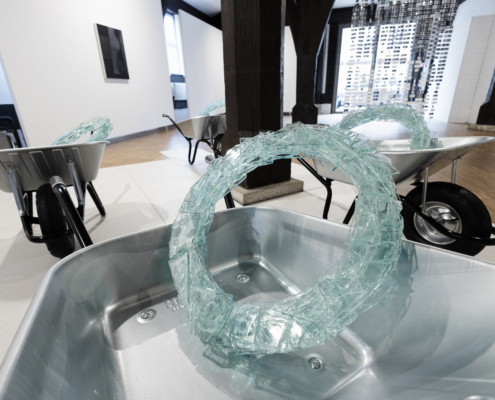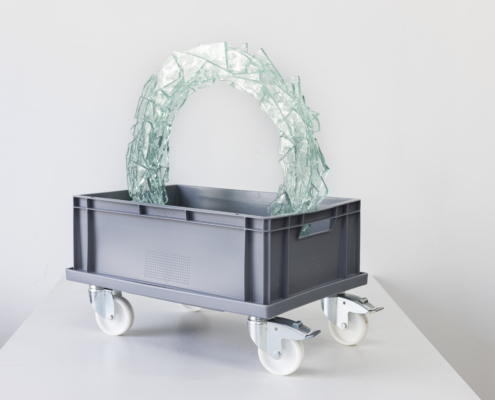ABOUT
Sander, wählt das Medium der Performance als immer wiederkehrende Konstante. Ihr eigener Körper ist dabei impulsgebender Initiator, eine Art Seismograf. In ihren Arbeiten sucht Finja Sander nach Brüchen und Ambivalenzen im Alltäglichen, nach unbewussten Automatismen, sich wiederholenden, gesellschaftlichen Mustern, die sie in der Folge, isoliert und innerhalb mehrteiliger, multimedialer Prozesse in neue Zusammenhänge bringt.
WORKS
Für Morgen_standort_1-12 (2023)
Für Morgen_standort_1-12 (2023)
eine performative Reihung
in Kooperation mit den Ernst Barlach Museen Güstrow, mit freundlicher Unterstützung durch die Leinemannstiftung für Bildung und Kunst
»(…) es galt mir, eine schwer ruhende Unbeweglichkeit als Ausdruck nie versiegenden Grams, hängend, weil der irdischen Bedingtheit entrückt, zu bannen.«
Ernst Barlach, 06. Februar 1929 über »Der Schwebende«
Für ihre performative Reihung »Für Morgen« entwickelt Finja Sander ausgehend von der Plastik »Der Schwebende« von Ernst Barlach eine neue Form kollektiven Erinnerns. Ihr Körper ist dabei der Schauplatz der Umwandlung von dem statischen Objekt in einen performativen Akt. Vergleichbar eines Re-enactments übersetzt sie Barlachs »Schwebenden« in ihre eigene Körperlichkeit und befragt dabei sowohl Erinnerungskultur als auch Denkmalgeschichte. In der Auswahl von Ernst Barlachs »Der Schwebende« erscheint dieses Vorhaben prädestiniert. Entgegen üblicher Ehrenmale, die stehend, meist sogar auf Sockeln angeordnet sind, schwebt Barlachs Bronze im Güstrower Dom und verweist so selbst auf ein andauerndes, inneres Beben. Für die Dauer von jeweils einer Stunde hängt Finja Sander in einem raumgreifenden Metallgestell über dem Boden. Gehalten wird sie durch drei orangefarbene Gurte, die wiederum auf die originale Konstruktion des »Schwebenden« verweisen.
Finja Sander stellt ihren eigenen Körper stets in den Mittelpunkt ihrer Arbeit. An ihm entwickeln sich ihre performativen Thesen. In »Für Morgen« inszeniert sie ihren regungslosen Körper gleichsam selbst als Skulptur. Doch trotz seiner Stille und Unbewegtheit, feiert die Performance das Faszinosum des atmenden, lebenden Körpers, als Gegenbild der plastischen Bronze. In dieser Übertragung ist »Für Morgen« eine eindrückliche Erweiterung des Ehrenmals von Barlach, das an die Toten des Ersten- und Zweiten Weltkriegs erinnert.
»Der Schwebende« selbst wurde im Zweiten Weltkrieg eingeschmolzen, Barlach als »entartet« verfemt. Durch das erhaltene Werkmodell konnte allerdings ein Nachguss veranlasst und versteckt werden, der heute in der Antoniterkirche in Köln hängt. Ein Drittguss kehrte letztlich an den ursprünglichen Platz des Ehrenmals, in den Güstrower Dom zurück.
Finja Sander stellt an ihrem eigenen Körper die Frage, wie wir erinnern wollen, und wo. Ihre Arbeit ist auch im Kontext einer Erinnerungskultur zu sehen, die zunehmend auf ihre Gültigkeit und Angemessenheit befragt wird.
Die performative Reihung »Für Morgen« wird an zwölf verschiedenen Orten, jeweils einmal im Monat aufgeführt. Die ausgewählten Locations orientieren sich u.a. an biografischen Stationen Barlachs, wie die Ernst Barlach Stiftung in Güstrow, beleuchten aber auch Teile der Werkgeschichte »des Schwebenden« selbst, wie das Olympiastadion Berlin, als Schauplatz nationalsozialistischer Aufmärsche. Weitere Stationen sind u.a.die Johanniskirche in Schwäbisch Gmünd – in Kooperation mit dem Festival für Europäische Kirchenmusik, sowie die SkulpturenTriennale in Bingen.
Durch die permanente Re-inszenierung der Performance an unterschiedlichen Orten, wird der Denkmalbegriff des »in Stein gemeißelten« pathetischen Erinnerns hinterfragt und weiterentwickelt. Folglich entsteht ein Erinnerungsnetz, das den »Schwebenden« buchstäblich aus der Statik einer Denkmalhistorie herausnimmt und in eine global lesbare Erinnerung überführt.
Finja Sander erfindet so einen neuen fluiden Denkmalbegriff
»Für Morgen«.
Text: Yoreme Waltz
The performative sequence Für Morgen_standort_1-12
(For Tomorrow_location_1-12) is difficult to grasp. Once built, a scaffold made of conventional metal rods and neon-orange ribbons stands by itself, only activated through the artist‘s performance, hanging in the frame for an hour at a time. She borrows the form and idea from the bronze figure “Der Schwebende” (The Floating One), which the artist Ernst Barlach created for the Güstrow Cathedral in 1927. The sculpture was at the time exhibited there with its eyes closed and arms folded, floating horizontally in a side chapel, where it was intended to convey „a heavy, resting immobility as an expression of never-ending grief“ arising from the death and suffering of the First World War. The result was a memorial that shifted away from current standards at the time: Instead of focusing on the heroic deeds of the soldiers standing on plinths, Barlach created a memorial image of mourning and guilt. This pacifist message prompted the National Socialists to decry the work as degenerate and melt it down in 1937. The hidden model of the work preserved the form of the sculpture, allowing it to be exhibited after the Second World War, first in the Antonite Church in Cologne and finally back in the Güstrow Cathedral. The post-war period and its burgeoning culture of reappraisal and remembrance led to Barlach‘s memorial being read as an increasingly relevant peace monument.
In times of crises and wars, “Der Schwebende” becomes increases once again in its contemporary relevance. However, Finja Sander‘s engagement with Barlach does not only constitute a quasi activist demand for peace. In these ambivalent times, where urges for peace are approriated for expressions of ignorance and a distortion of history while calls for increasing militarisation are being made, Sander turns to the mechanisms of remembrance. She is less interested in an evaluation of peace and war than in the emergence and role of German monuments and the culture of remembrance, which gained importance in the context of the two world wars and the National Socialist crimes. In this interest lies the hope of emphasizing the relevance of remembrance for the present and developing new ways of dealing with the German past.
In her interest in Barlach‘s memorial, Sander takes the floating posture of the sculpture literally and approaches it through her own bodily experience. The body thus becomes a site for the transformation of sculpture into a performative act. In her endeavor to become an object herself, to give up her own physicality and to subordinate herself to the resulting image, Sander draws on many of her earlier performances.
Für Morgen_standort_ 1-12 was performed once every month at a total of twelve different locations over the course of 2023. This creates a repetitive rhythm that expresses the need to continuously engage with German remembrance culture. In an experimental manner, the artist confronts locations related biographically to Barlach or places that are charged with the National Socialist past as well as sites related to the work beyond these references. Sander posits that questions of memory and guilt are localized everywhere in Germany and the need to ask them is always present. Within the contrast between rigid objecthood and fluid humanity, Sander scrutinizes the role of memorials and at the same time develops it further with an understanding of a peaceful present and future that can only be found in an examination of the past and the mechanisms of remembrance.
Text: Nikolas Geier
selected Performances
recent works
CV
*1996 in Hildesheim (Niedersachsen), lebt und arbeitet in Berlin
2022 Meisterschülertitel mit Auszeichnung, Prof. Valérie Favre
2015-2022 Studium der Bildenden Kunst, Universität der Künste, Berlin
Grants, Awards, Residencies
2024 Residency Kunstverein Augsburg
2023 Residency Kunstverein Schwäbisch Gmünd
2023 UdK Berlin Art Award, Recipient
2022 Förderpreis Junge Kunst, Rathaus-Galerie Reinickendorf, Berlin (shortlist)
Performances (selection)
2024
In einem Land vo unserer Zeit, Kunstverein Augsburg
Performance 40, Arco Madrid, Galerie Jochen Hempel
2023
Für Morgen_standort_12, Zitadelle Spandau, Ausstellung Enthüllt, Berlin
Performance 39, Kunstverein OST, Berlin
Für Morgen_standort_11_Mahnmal (Karlsaue), Kassel
Für Morgen_standort_10_Stiftersaal, Wallraf-Richartz-Museum, Köln
Für Morgen_standort_09_Krugberg, Seelower Höhen, Brandenburg
Für Morgen_standort_08_Willy-Brandt-Haus, Berlin
Für Morgen_standort_07, Johanniskirche, Schwäbisch Gmünd
Für Morgen_standort_06, Skulpturentriennale, Bingen am Rhein
Für Morgen_standort_05, Universität der Künste, Berlin
Für Morgen_standort_04, Olympiastadion Berlin
Für Morgen_standort_03, Barlach Museen Güstrow
Für Morgen_standort_02, Dokumentationszentrum Prora, Rügen
Für Morgen_standort_01, Truppenübungsgebiet Döberitzer Heide, Brandenburg
2022
Performance 36, colorado projects, Galerie Jochen Hempel, Leipzig
Performance 34, colorado projects, Galerie Jochen Hempel, Leipzig
Adieu (Performance 33), Meisterschülerausstellung UdK Berlin
Performance 31, Auktionshaus Grisebach, Berlin
2021
Performance 29, Spoiler Aktionsraum, Berlin Moabit
Performance 27, Hamburger Bahnhof, Berlin
Performance 26, Museum für Fotografie, Berlin
Performance 21, Gmünder Kunstverein, Schwäbisch Gmünd
Solo Shows
2024
In einem Land vor unserer Zeit, Kunstverein Augsburg
2023
galerie burster during Gallery Week, Berlin, DE
archiv SANDER I SCHAAL x Galerie Georg Nothelfer during Gallery Week, Berlin, DE
Tat es weh, als du vom Himmel gefallen bist?, Soloshow, Gmünder Kunstverein, Schwäbisch Gmünd
Fernab jeglicher Schwere, Soloshow, galerie burster, Karlsruhe
2022
EINFRIEDUNG, galerie burster Berlin
Group Shows
2023
CUT, Museum Haus des Papiers, Berlin
nature mortes, galerie burster, Berlin
Out Of Office, galerie burster, Berlin
2022
All I Want, galerie burster, Berlin
groupshow, Galerie C Neuchatel, Schweiz
Excuse me, I am looking for the rabbit hole, curated by Fanny Dommers and Nikolas Geier, Culterim Gallery, Berlin
I got you covered, curated by Pola van den Hövel and Julia Meyer-Brehm, Culterim Gallery, Berlin
Förderpreis Junge Kunst 2022, Rathausgalerie Reinickendorf, Berlin
Nicht das Fell berühren, curated by Pierre Granoux,
LAGE EGAL [in the Rackroom], Berlin, with Daniel M.E. Schaal
Free Space (for UKR), benefit exhibition, curated by Pierre Granoux, LAGE EGAL, Berlin
2021
PROLOG: never gonna give you up, curated by Jakob Urban, ROAM, Berlin
EINSTAND, kuratiert von Jakob Urban, Steinplatz, Berlin, mit Daniel M.E. Schaal
Direkte Auktion, Slot 4, kuratiert von Miriam Schwarz, Galerie Burster, Berlin
Club Quarantina II, kuratiert von Gilles Neiens, Galerie Wild Palms, Düsseldorf
This one time at HEW, kuratiert von Elana Katz
in Kooperation mit KWADRAT GALERIE, mit Daniel M.E. Schaal
Nothing ever happened [yet], kuratiert von Maren Lübbke-Tidow, Museum für Fotografie, Berlin
The Performing Object, kuratiert von Justin Polera, Kunstraum Potsdamer Straße, Berlin
Club Quarantina I, kuratiert von Gilles Neiens, Grimm Museum, Berlin










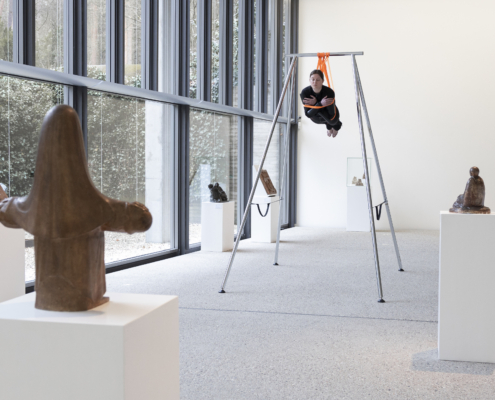















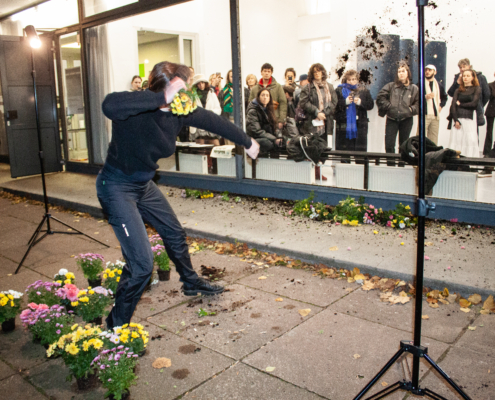







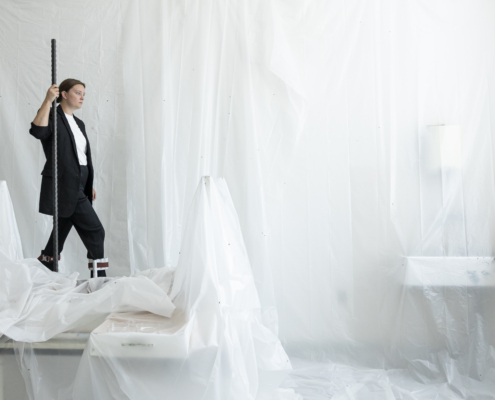














![FINJA SANDER_passiv agressiv [set up], 2023](https://jochenhempel.com/wp-content/uploads/2024/03/FINJA-SANDER_passiv-agressiv-set-up-2023-495x400.jpg)




